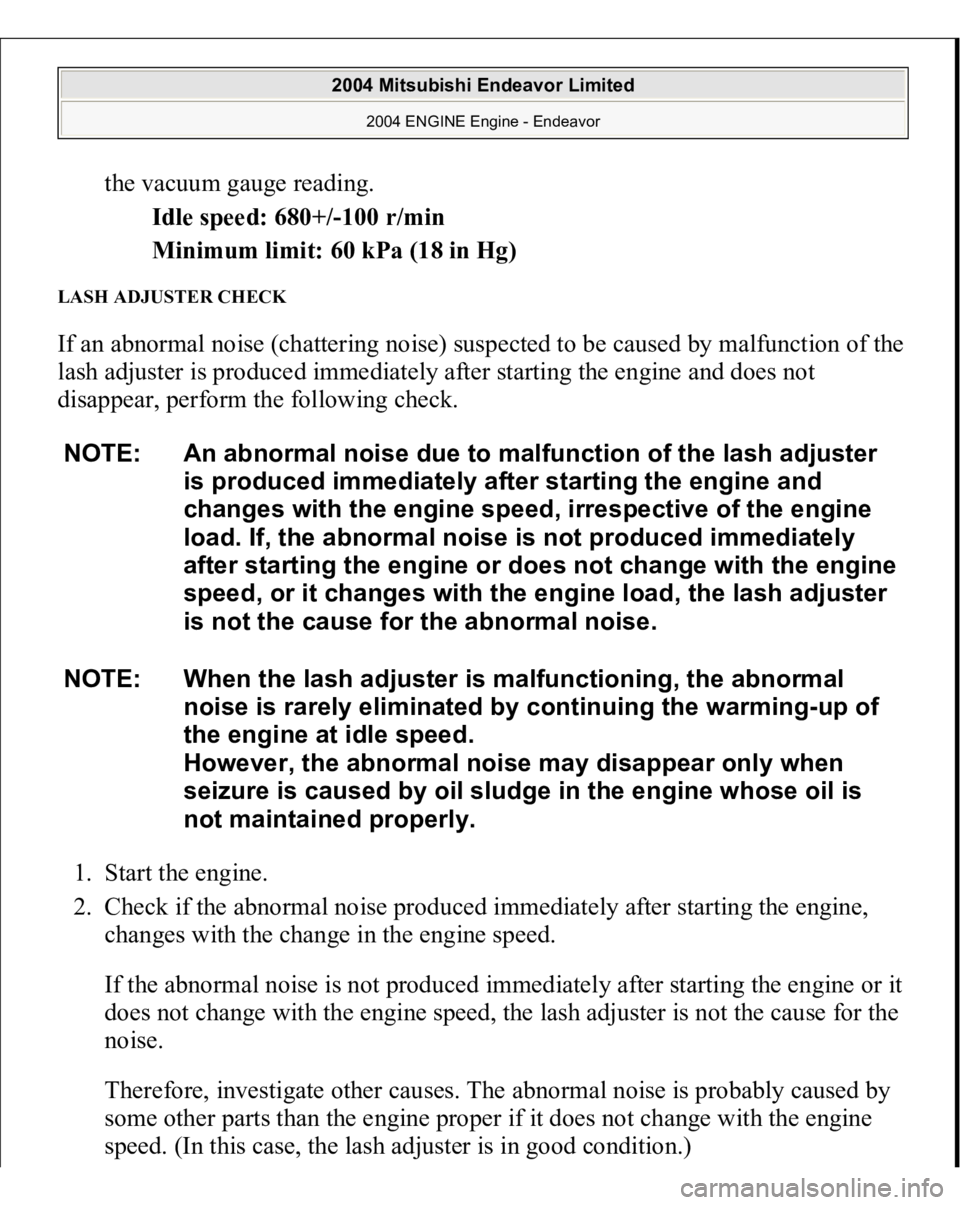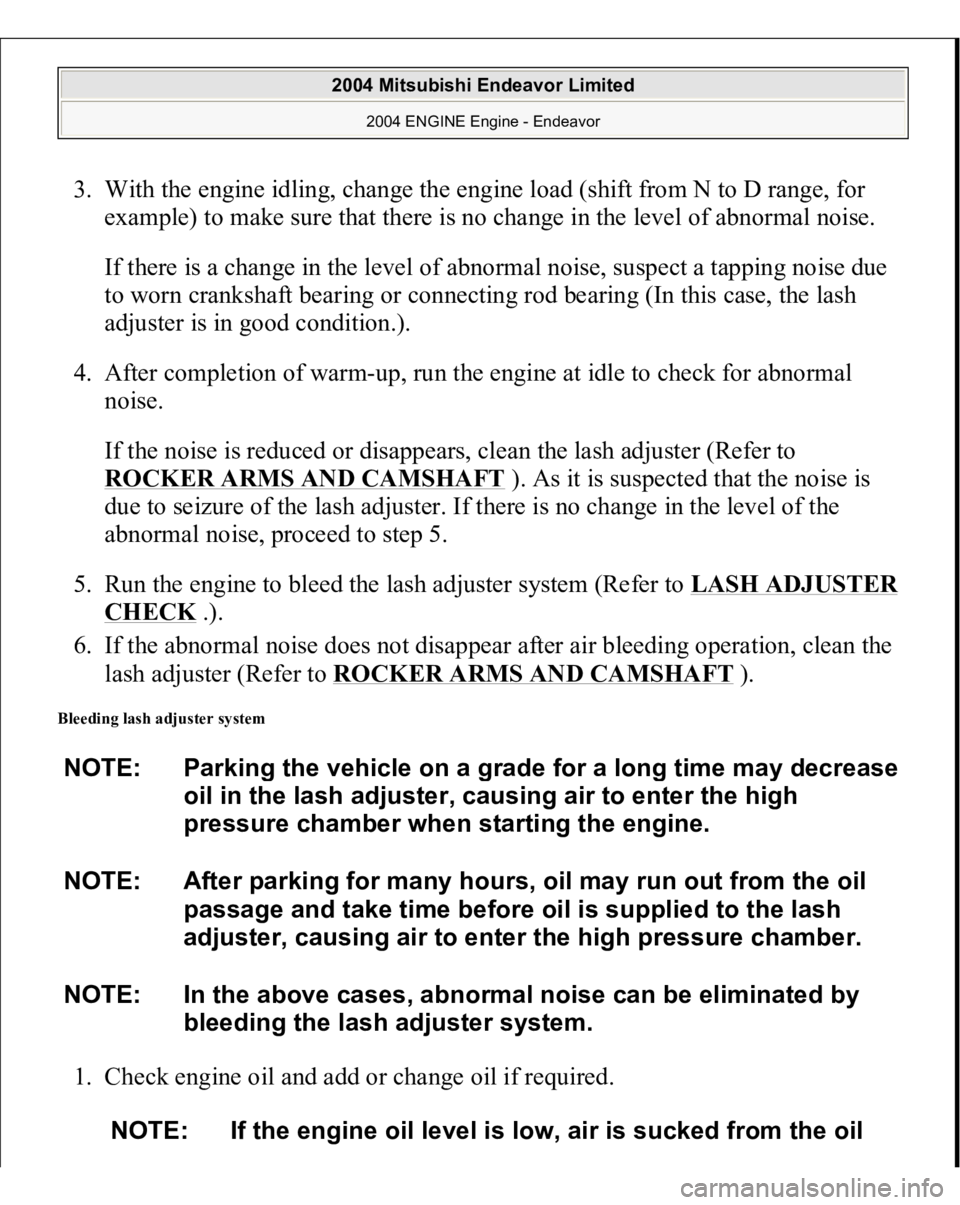Page 1526 of 3870
Fig. 21: Disconnecting Crankshaft Position Sensor Connector
Courtesy of MITSUBISHI MOTOR SALES OF AMERICA.
4. Cover the spark plug hole with a shop towel etc., during cranking. After the
engine has been cranked, check for foreign material adhering to the shop towel.
5. Set compression gauge to one of the spark plug holes.
WARNING:Keep your distance from the spark plug hole
when cranking. Oil, fuel, etc., may spray out
from the spark plug hole and may cause serious
injury.
2004 Mitsubishi Endeavor Limited
2004 ENGINE Engine - Endeavor
Page 1527 of 3870
Fig. 22: Setting Compression Gauge To One Of Spark Plug Holes
Courtesy of MITSUBISHI MOTOR SALES OF AMERICA.
6. Crank the engine with the throttle valve fully open and measure the
compression pressure.
Standard value (at engine speed of 200 r/min): 1,548 kPa (225 psi)
Minimum limit (at engine speed of 200 r/min): 1,117 kPa (162 psi)
7. Measure the compression pressure for all the cylinders, and check that the
pressure difference of the cylinders are below the limit.
Limit: 98 kPa (14 psi)
8. If there is a cylinder with compression or a compression difference that is
outside the limit, pour a small amount of engine oil through the spark plug
hole, and repeat the operations in steps 6 to 8.
1. If the com
pression increases after oil is added, the cause of the
2004 Mitsubishi Endeavor Limited
2004 ENGINE Engine - Endeavor
Page 1530 of 3870
Courtesy of MITSUBISHI MOTOR SALES OF AMERICA
.
MANIFOLD VACUUM CHECK 1. Start the engine and allow it to warm up until the temperature of the engine
coolant reaches 80 - 95°C (176 - 203°F).
2. Connect an engine tachometer.
3. Disconnect the ventilation hose from the positive crankcase ventilation (PCV)
valve, and connect a vacuum gauge to the ventilation hose.
Fig. 24: Disconnecting Ventilation Hose From Positive Crankcase
Ventilation Valve
Courtesy of MITSUBISHI MOTOR SALES OF AMERICA.
4. Plug the PCV valve.
5. Start the en
gine and check that idle s
peed is within s
pecification. Then check
2004 Mitsubishi Endeavor Limited
2004 ENGINE Engine - Endeavor
Page 1531 of 3870

the vacuum gauge reading.
Idle speed: 680+/-100 r/min
Minimum limit: 60 kPa (18 in Hg)
LASH ADJUSTER CHECK If an abnormal noise (chattering noise) suspected to be caused by malfunction of the
lash adjuster is produced immediately after starting the engine and does not
disappear, perform the following check.
1. Start the engine.
2. Check if the abnormal noise produced immediately after starting the engine,
changes with the change in the engine speed.
If the abnormal noise is not produced immediately after starting the engine or it
does not change with the engine speed, the lash adjuster is not the cause for the
noise.
Therefore, investigate other causes. The abnormal noise is probably caused by
some other parts than the engine proper if it does not change with the engine
speed. (In this case, the lash adjuster is in good condition.)NOTE: An abnormal noise due to malfunction of the lash adjuster
is produced immediately after starting the engine and
changes with the engine speed, irrespective of the engine
load. If, the abnormal noise is not produced immediately
after starting the engine or does not change with the engine
speed, or it changes with the engine load, the lash adjuster
is not the cause for the abnormal noise.
NOTE: When the lash adjuster is malfunctioning, the abnormal
noise is rarely eliminated by continuing the warming-up of
the engine at idle speed.
However, the abnormal noise may disappear only when
seizure is caused by oil sludge in the engine whose oil is
not maintained properly.
2004 Mitsubishi Endeavor Limited
2004 ENGINE Engine - Endeavor
Page 1532 of 3870

3. With the engine idling, change the engine load (shift from N to D range, for
example) to make sure that there is no change in the level of abnormal noise.
If there is a change in the level of abnormal noise, suspect a tapping noise due
to worn crankshaft bearing or connecting rod bearing (In this case, the lash
adjuster is in good condition.).
4. After completion of warm-up, run the engine at idle to check for abnormal
noise.
If the noise is reduced or disappears, clean the lash adjuster (Refer to
ROCKER ARMS AND CAMSHAFT
). As it is suspected that the noise is
due to seizure of the lash adjuster. If there is no change in the level of the
abnormal noise, proceed to step 5.
5. Run the engine to bleed the lash adjuster system (Refer to LASH ADJUSTER
CHECK
.).
6. If the abnormal noise does not disappear after air bleeding operation, clean the
lash adjuster (Refer to ROCKER ARMS AND CAMSHAFT
).
Bleeding lash adjuster system 1. Check engine oil and add or change oil if required. NOTE: Parkin
g the vehicle on a
grade for a lon
g time ma
y decrease
oil in the lash adjuster, causing air to enter the high
pressure chamber when starting the engine.
NOTE: After parking for many hours, oil may run out from the oil
passage and take time before oil is supplied to the lash
adjuster, causing air to enter the high pressure chamber.
NOTE: In the above cases, abnormal noise can be eliminated by
bleeding the lash adjuster system.
NOTE: If the engine oil level is low, air is sucked from the oil
2004 Mitsubishi Endeavor Limited
2004 ENGINE Engine - Endeavor
Page 1533 of 3870
Fig. 25: Checking Engine Oil Level
Courtesy of MITSUBISHI MOTOR SALES OF AMERICA.
screen, causing air to enter the oil passage.
NOTE: If the engine oil level is higher than specification, oil
may be stirred by the crankshaft, causing oil to be
mixed with a large quantity of air.
NOTE: If oil is deteriorated, air is not easily separated from oil,
increasing the quantity of air contained in oil.
2004 Mitsubishi Endeavor Limited
2004 ENGINE Engine - Endeavor
Page 1534 of 3870
Fig. 26: Identifying High Pressure Chamber
Courtesy of MITSUBISHI MOTOR SALES OF AMERICA.
2. Idle the engine for one to three minutes to warm it up.
3. Repeat the operation pattern, shown in left figure, at no load to check for
abnormal noise. (Usually the abnormal noise is eliminated after repetition of
the ope
ration 1
0 to 30 tim
es.
If, howeve
r, no change is obse
rved
in
the leve
l of
NOTE: If air mixed with oil enters the high pressure chamber
inside the lash adjuster from the above causes, air in
the high pressure chamber is compressed excessively
while the valve is opened, resulting in an abnormal
noise when the valve closes. This is the same
phenomenon as that observed when the valve
clearance has become excessive. The lash adjuster can
resume normal function when air entered the lash
adjuster is removed.
2004 Mitsubishi Endeavor Limited
2004 ENGINE Engine - Endeavor
Page 1543 of 3870
Fig. 35: Holding Engine Assembly With A Chain Block
Courtesy of MITSUBISHI MOTOR SALES OF AMERICA.
5. Place a garage jack against the engine oil pan with a piece of wood in between
so that the weight of the engine and transaxle assembly is no longer being
applied to the engine mount.
6. Loosen the engine mount mounting nuts and bolts, and remove the engine
mount.
<< F >>ENGINE ASSEMBLY REMOVAL After checking that all cables, hoses and wiring harness connectors and so on are
disconnected from the engine, lift the chain block slowly to remove the engine
assembly upward from the engine compartment. INSTALLATION SERVICE POINTS >>A<< ENGINE ASSEMBLY INSTALLATION
2004 Mitsubishi Endeavor Limited
2004 ENGINE Engine - Endeavor